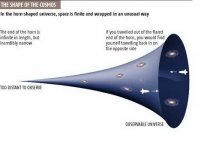Now now, no need for insults. This is a friendly discussion, no?Look how efficient selective quoting can be, Pete!
The comments are attributed to 'BigNewGames' and here he is on YouTube:
BigNewGames - YouTube
If a draftsman can make such profound comments, then why not a drywaller?
So what do you think about this guy's kooky perspective?
I thought I made that clear in the following post.So what do you think about this guy's kooky perspective?
P.S. No insult was intended. If that guy can challenge current cosmological ideas then so can you, I, Uncle Tom Cobley and all!
If I was out on a limb I'd say he's correct.

So now that you're in research mood, can I bend your ear/eye to answer this question if it's answerable: Hypothetically, if a person falls into a black hole, would they have a sensation of falling forever as in like a bottomless pit? That is if they could live forever.
First of all it's not a hole despite the unfortunate name. It a solid body in the shape of a sphere and it has a very high density. Very....... high. How would i know its "round" as a ball i.e. a sphere. Well, any body of considerable mass, like earth or the moon, could not sustain to maintain any other shape due to gravity. Here you also have the reason why flat-eartheners are wrong.
So when you fall down on a supermassive body (what you referred to as a black hole), you are sliced, shredded and grind to pieces before you hit ground.
You are welcome
//
A black hole is a tremendous amount of matter crammed into a very small (in fact, zero) amount of space - called a singularity.
When we talk about 'entering' a black hole, we mean crossing its event horizon Event horizon - Wikipedia after which we would fall towards the singularity.
No one knows what happens when you enter the singularity. The laws of physics, as we know them, don't apply there. Perhaps you would be crunched down not just to cells or even atoms, but to a perfect sea of energy - but that's just conjecture.
When we talk about 'entering' a black hole, we mean crossing its event horizon Event horizon - Wikipedia after which we would fall towards the singularity.
No one knows what happens when you enter the singularity. The laws of physics, as we know them, don't apply there. Perhaps you would be crunched down not just to cells or even atoms, but to a perfect sea of energy - but that's just conjecture.
Magnetars and neutron stars interest me. Magnetars have mag field strengths of 10^9 to 10^10 T (the Schwinger limit starts at 10^18)
Magnetar - Wikipedia
Magnetar - Wikipedia
Last edited:
A list of known magnetars is given in Bonsai's Wikipedia link.
As of November 2020, there are 29 known magnetars in our Milky Way galaxy.
Magnetars were thought to be responsible for Fast Radio Bursts (FRBs) and this was confirmed in April 2020 when multiple radio telescopes detected an FRB from a magnetar near the center of the Milky Way.
The dozens of other FRBs detected before that had all come from far outside our galaxy, making it impossible to track their source.
As of November 2020, there are 29 known magnetars in our Milky Way galaxy.
Magnetars were thought to be responsible for Fast Radio Bursts (FRBs) and this was confirmed in April 2020 when multiple radio telescopes detected an FRB from a magnetar near the center of the Milky Way.
The dozens of other FRBs detected before that had all come from far outside our galaxy, making it impossible to track their source.
Oh thanks. It slipped my noticeA list of known magnetars is given in Bonsai's Wikipedia link.
As of November 2020, there are 29 known magnetars in our Milky Way galaxy.
Magnetars were thought to be responsible for Fast Radio Bursts (FRBs) and this was confirmed in April 2020 when multiple radio telescopes detected an FRB from a magnetar near the center of the Milky Way.
The dozens of other FRBs detected before that had all come from far outside our galaxy, making it impossible to track their source.
The mag field strengths are so strong that atoms are squeezed into long thin shapes so anything within a thousand miles gets ripped to shreds. The mag field is still well below the Schwinger limit (10^18 T which is when free space is no longer magnetically linear anymore)
The other interesting objects are quasars.
BTW just finishing off reading Stephen Weinberg’s ‘The First Three Minutes’. Written in the mid 1970’s it’s a bit outdated, but there’s a prologue at the back that pulls much of it into the mid 1990’s. (Useful math addendum at the back of the book as well)
The other interesting objects are quasars.
BTW just finishing off reading Stephen Weinberg’s ‘The First Three Minutes’. Written in the mid 1970’s it’s a bit outdated, but there’s a prologue at the back that pulls much of it into the mid 1990’s. (Useful math addendum at the back of the book as well)
Quasars are among the brightest objects in the universe - luminous, active galactic nuclei powered by supermassive black holes that are actively feeding on nearby material.The other interesting objects are quasars.
Recently, scientists have found the most distant quasar yet known, residing about 13 billion light-years from Earth. They estimate that this particular quasar's seriously supermassive black hole ingests an amount of mass equivalent to 25 Suns every year.
The first quasar ever to be identified is 3C 273, which is one of the closest quasars to us at a mere 2.5 billion light-years away. It was discovered in the 1960s.
Attachments
The energy is emitted by the material near the supermassive black hole which forms a hot accretion disc revolving at speeds of hundreds of thousands of miles per hour as the material spirals in towards the black hole and heats up to temperatures of millions of degrees.
Last edited:
We have a supermassive black hole at the centre of our Milky Way galaxy, but currently it is quiescent.
However, there is evidence to suggest that it may have been an active quasar just a few million years ago.
This evidence is in the form of two giant bubbles that extend 25,000 light-years above and below the galactic center and are emitting gamma rays.
However, there is evidence to suggest that it may have been an active quasar just a few million years ago.
This evidence is in the form of two giant bubbles that extend 25,000 light-years above and below the galactic center and are emitting gamma rays.
Attachments
Last edited:
- Status
- Not open for further replies.
- Home
- Member Areas
- The Lounge
- What is the Universe expanding into..
 Lots of questions without answers there.
Lots of questions without answers there.

